Barry Van Dusen
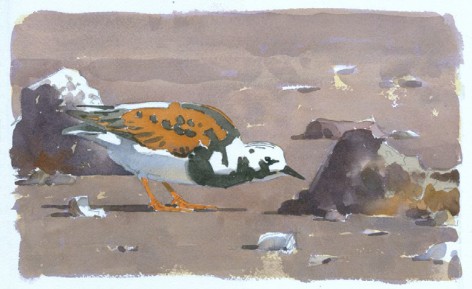
Ruddy Turnstone. All images by the author.
Artist-in-Residence programs have proliferated in recent years, and offer people like me a variety of opportunities for work and travel. In the past decade, I’ve taken part in four residency programs around New England, and have found them to be productive and fun. From my point of view, the best thing about these programs is the chance to work outdoors on a regular basis.
When Amy Montague, director of Mass Audubon’s Museum of American Bird Art, approached me in 2014 with the idea of a Mass Audubon “statewide residency,” I was ready to go! I knew it would be my most ambitious residency yet, and I insisted on a two-year working period. I wanted to give each sanctuary the attention it deserved, and didn’t want to rush the visits. I agreed to write up my visits in a Mass Audubon blog, where I would also post sketches, paintings and related photographs. The project will culminate in an exhibition at the Museum of American Bird Art in Canton, MA from May 21 to September 17, 2017.
When I started the project, there were 54 public sanctuaries, but two more came online in 2015, and in addition, I decided to include Mass Audubon’s Wildwood Camp in Rindge, New Hampshire. This brought the total number of properties to 57—and that was my goal for the two-year working period. I have been a Mass Audubon member for many years, and during that time had visited many of the Society’s properties, but I had certainly not visited all of them. Now I had no excuse!
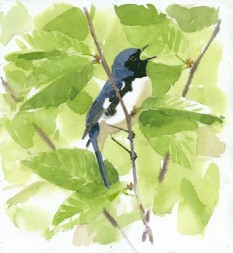
Black-throated Blue Warbler in Birch, Eagle Lake, Holden.
I typically spend a full day at each location, although some properties are visited more than once. On every visit I carry a 9” x 12” sketchbook for notes and pencil studies, but I also carry several types of watercolor paper and a full watercolor kit. For optics I carry 8x binoculars and a 25x scope, along with a small digital camera.
Initially, I thought I might do all of the watercolor paintings on location, but I quickly realized that this approach was too limiting. Some subjects, like nesting birds, landscapes, and botanical subjects, easily lend themselves to location work, while others prove more challenging. I also realized that some of my best ideas for pictures come to me after a visit, when I’ve had the leisure to mull over my experiences and ponder on the imagery. As it is turning out, about half of the watercolors are produced in the field, and the rest are done in my studio.
In some instances, I’ve timed my visits to work with very specific subjects, like the yellow lady’s slippers at High Ledges or the purple-fringed orchids at West Mountain. For places like Marblehead Neck or Sampson’s Island, I made sure to visit at the most productive time of year. Occasionally, I’ve taken advantage of unexpected weather events, like the spring snowstorm on March 21, 2016, at the end of a mild, open winter.
In general, I did not work towards any predetermined list of species or sanctuary specialties, though many of the subjects I painted would fit that description. My primary aim was to take advantage of artistic opportunities as I encountered them, and at every location a good deal of serendipity was involved. Along the way, I hope I’ve created a body of work that celebrates the richness and biological diversity of Massachusetts and the Mass Audubon sanctuary system.
I’ve painted many birds for the project, but also worked with landscapes (some featuring Mass Audubon buildings), flowers and plants, butterflies, dragonflies and other insects, mammals, salamanders, turtles, frogs, and fish. Looking at the entire body of work, I see an obvious bias toward certain subjects, and for this I make no apologies. I tell my students: Draw what you love and it will be reflected in your work!
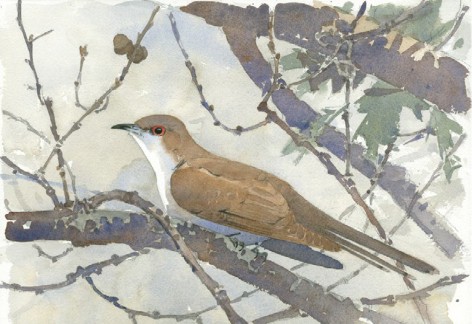
Black-billed Cuckoo, Burncoat Pond, Spencer.
Here are some of the observations I made in the course of writing my posts for the Taking Flight blog:
May 11, 2015, Eagle Lake, Holden—As I hike in along the Appleton Loop trail, it becomes obvious that Black-throated Blue Warblers are the most abundant warbler at this site. Every quarter mile or so, I encounter another Black-throated Blue singing from the sweet birches that arch above the mountain laurel thickets. Pausing along the trail, a female circles and scolds me—I must be near a nest, so I move on…
May 26, 2015, Ashumet Holly, Falmouth—Drawing birds, as opposed to photographing them or birding, entails observing and studying individual birds for relatively long periods of time. Perhaps because of this, I often find bird nests during my fieldwork. I’ll notice that a bird I’m drawing is hanging around one particular spot, or I’ll see a bird carrying nest material. Today I found the nests of a Yellow Warbler, a Baltimore Oriole, and an Orchard Oriole!
June 24, 2015, Burncoat Pond, Spencer —While I’m eating lunch under a big sugar maple near the parking area, a bird flies into the branches over my head. Something about the bird looks interesting, but I can’t locate it among the maple leaves. Finally, it moves to an oak across the road and I quickly get my scope on it—a Black-billed Cuckoo! Good looks at cuckoos never seem to last very long, and this one is no different, giving me just one good look before it disappears. I rarely try to develop a painting from such a brief look, but the impression was a strong one, so I take out my sketchbook and get down as much as possible of what I remember. I’ve learned that it’s sometimes good to force myself to work from memory; it has a way of distilling and intensifying a field experience.
July 19, 2015, West Mountain, Plainfield—As I’m assembling my gear to hike the trails, I hear a commotion in the woods across the street, and a young bear pokes its head out of the thick roadside vegetation and looks straight at me! I must look threatening because the animal makes a hasty retreat back into the woods, only to circle around and do the same thing again. The bear clearly wants to cross the road, but after its second retreat it must have decided to cross elsewhere. The fact that it made so much noise in the woods was reassuring, since it would be unlikely to take me by surprise if I encounter it again.
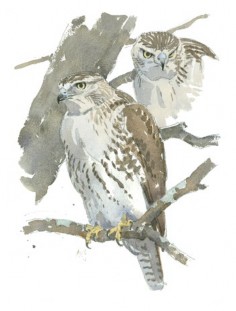
Young Red-tailed Hawk, Habitat Sanctuary.
July 24, 2015, Stony Brook, Norfolk—Heading back to the visitor center, I hear the distinctive notes of a Purple Martin. Upon my arrival at the sanctuary earlier, I had noticed the martin house in the big field next to the parking area, but had seen only House Sparrows perched there. Now, I focus my scope on the house and find a single martin perched on the top mast. Later, I asked sanctuary director Doug Williams about the birds and was pleased to hear that the martins were in their third year of using the box and that this year three nests had produced a total of 10 young birds. I saw no more martins this day, but was happy to know that the colony is on the increase.
August 17, 2015, Long Pasture, Barnstable—The tide is low, and there are many birds spread out and feeding on the mudflats in front of me. I greatly enjoy drawing birds at the shore, where my spotting scope really comes into its own. As I work quietly from one spot, the birds soon forget my presence and some of them approach quite closely. After a while, some kids arrive, remove their shoes and socks, and head out on the flats to explore. This puts an end to my drawing as the birds quickly move away, but I’ve had a good session, and am happy to see the kids getting excited over the crabs, snails, and worms that they find.
October 6, 2015, Lincoln Woods, Leominster—As I’m about to depart, a movement along the opposite shore catches my eye, and I focus my binoculars on two Blackpoll Warblers that have come to bathe in the vernal pool. The bright olive hues of the birds make an unexpected contrast with the somber colors of the shoreline, and their reflections seem to glow on the dark waters. Within minutes the birds have moved on, and the pool is once again quiet and still. I make some quick sketches to fix the scene in my mind.
October 25, 2015, Moose Hill, Sharon—The rocky ridge top of the Bluff Overlook (elevation 491 feet) hosts a plant community quite distinct from that of the surrounding forests. Eastern red cedars are the most conspicuous feature, but there’s also a predominance of pignut hickory, and a small shrub-like oak called bear oak. Another prominent feature visible from the overlook is Gillette Stadium. I arrive on the ridge about an hour before game time, and Gillette is lit up like a spaceship—glowing in the fog and light drizzle (yes, the rain persists!). Rock music from the public address system drifts over the intervening hills.
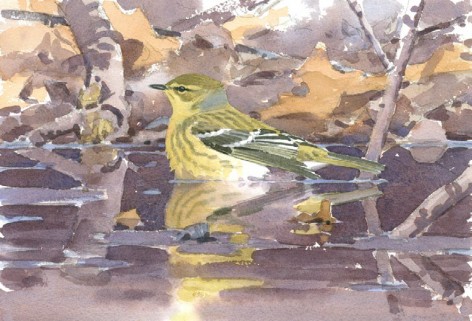
Blackpoll Warbler bathing in vernal pool.
January 26, 2016, Eastern Point, Gloucester—Gloucester is a popular winter destination for birders, so I am not surprised to meet some today, including Jim Berry, an expert on Essex County birds. He helps me sort out the gulls that are present, and points out a group of about forty Purple Sandpipers hunkered down on the lee side of the Dog Bar Breakwater. Most of the birders are, of course, moving from spot to spot in search of “good birds,” whereas I confine my observations to the sanctuary and the immediate vicinity. If you want to “do art,” you can’t run around a lot, too!
February 29, 2016, Habitat, Belmont—Are there more Red-tailed Hawks around these days, or is it just me? I’m watching a Hairy Woodpecker at Weeks Meadow when a big bird swoops in to land in the lower branches of a nearby tree. It’s a handsome young Red-tail attracted to a noisy mob of House Sparrows in the thicket below. Young birds, being rather clueless, can be excellent models. I’m in full view of the bird, and though I move myself and the scope several times to get better views, it seems totally oblivious to my presence.
March 22, 2016, Arcadia, Easthampton—The eagle nest, by its sheer size, is easy to locate, but to get the best views requires careful positioning of my scope and field stool on the hillside above Ned’s Ditch. I settle down to watch. The nest is placed in a main crotch near the top of a large, live tree (oak?), and is truly MASSIVE in size—so much so that the bird’s head, protruding above the mass of sticks and twigs, looks ridiculously tiny! I later learned that Bald Eagles make the largest nest of any single pair of birds.
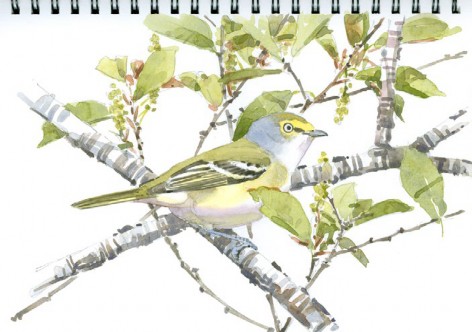
White-eyed Vireo in Cherry.
May 4, 2016, North River, Marshfield—In the lower end of the meadow, a big platform has been erected to attract nesting Ospreys, and sure enough, a bird sits on the nest, likely incubating eggs. The platform was erected in 2009, but this is the first year ospreys have used it to establish a nest. Needless to say, David Ludlow and the staff are excited! With my scope, I have superb close-up views of the incubating bird. I get to work with my sketchbook, attempting to capture the angular shapes of the head and that intense, angry look on the bird’s face.
May 19, 2016, Marblehead Neck, Marblehead—As with many types of birding, hitting a place like this on just the right day is largely a matter of luck. The day I visited did not coincide with any spectacular fall-outs, but neither did it disappoint. Arriving at the parking area at 10:15 am, I claimed the last parking spot. It had been a busy morning, and some birders were just returning to their cars. They had the usual report: “You should have been here yesterday.” However, I could hear a Blackpoll Warbler, a Magnolia Warbler, and a Black-throated Green Warbler from the parking lot, so how bad could it be?
May 28, 2016, Allens Pond, Dartmouth—I’m surrounded on three sides by coastal scrub: dense thickets of shrubs and low trees that are home to a variety of birds. Catbirds and Yellow Warblers are abundant, but an unfamiliar song captures my attention. It’s a loud, persistent song starting and ending with a sharp chip. I jot it down in my sketchbook thus: “chip-che-wheeyou-chip!” For 45 minutes I stare intently into the thickets, trying to pinpoint just where that song is coming from. Persistence finally pays off when the bird moves to a slightly higher perch in a small cherry tree, and I have a clear view of a White-eyed Vireo. Only later do I read that these birds usually sing from a low, concealed perch!
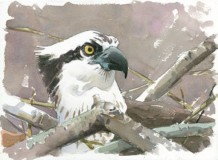
Osprey on nest.
June 30, 2016, Ipswich River, Topsfield—When I pause along the trail, I notice an interesting phenomenon: small birds—mostly titmice and chickadees—approach me closely, coming to within arm’s length. Later, as I work on a watercolor, a White-breasted Nuthatch approaches on a tree trunk and inspects me with a curious expression. This happens at least three times while I’m painting, and I’m beginning to fancy that through some mysterious telepathy, the birds recognize me as a kindred spirit. Back in the parking lot, I relate these “close encounters” to Sandy Selesky (a regular visitor), and she laughs, explaining that Ipswich River Wildlife Sanctuary is well known to locals as a place where the birds have become habituated to taking hand-outs of food from visitors. So much for my communion with the birds!
July 11, 2016, Sampson’s Island, Cotuit—This is my first sanctuary visit that requires a boat. I meet two coastal waterbird wardens at a rendezvous point in Cotuit, and load my field kit into a small, open runabout. Brad Bower is the Sampson’s Island crew leader, and his associate is Brian Lonabocker. They are students of biology and environmental science, and this is a summer job for them. Today, they load signs into the boat, which they’ll be posting in various spots around the island. During the peak breeding season, boats are not allowed to land on the island, in order to safeguard the birds during this critical period.
July 12, 2016, Daniel Webster, Marshfield—I notice a movement at the base of the cattails, and watch a Virginia Rail emerge into the open water, followed closely by another, darker bird. A moorhen or coot??? No, it’s too small and the bill isn’t right for either of these species. It’s charcoal black, save for a few fuzzy patches of chestnut, and the bill is dark and thin, with a pale nostril and pale tip. It is, of course, a young Virginia Rail! It shadows the adult closely, following every movement of its parent with keen interest. The adult finds what looks like a dead frog or tadpole, and both birds take turns poking, prodding, lifting, and tossing. The show is over all too soon, and the birds melt back into the cattails…
August 19, 2016, Wellfleet Bay, South Wellfleet—Where the Try Island Trail meets the boardwalk to the beach, I meet a group of volunteers who are monitoring diamondback terrapin nests. Each nest is protected by a wire enclosure, and I’ve encountered many of them as I walk the trails. The nest monitors, Theresa Hultin, Steve Monroe, and Nancy Munger, kindly allow me to watch as they assist at a hatching nest. The number of hatchlings and eggshells are carefully counted and recorded in a log, along with location of the nest, time of hatching, and the depth of the nest. Theresa, the team leader, tells me that 85 terrapin nests have been located on the sanctuary this year. Each nest, if it is not disturbed by predators, will produce between 12 and 22 young turtles.
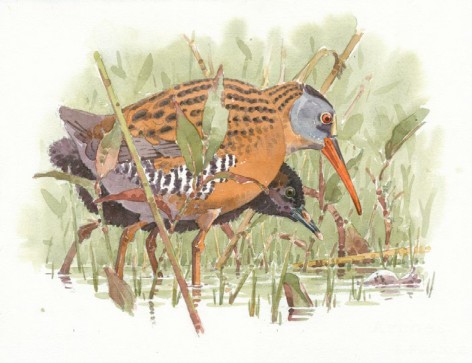
Virginia Rail and young.
September 2, 2016, Boston Nature Center, Mattapan—On the Snail Trail, I pass through a mature forest of oaks and silver maples, interrupted by sunny glades of lush undergrowth. I watch a flock of young starlings gorging on wild grapes, and make some drawings. Young starlings display this unusual plumage for only a short time in late summer. Their tawny gray heads are set off by black vests densely spangled with bold white spots. A black “bandit mask” on the face gives them an intense, slightly sinister look. The combination of the fruiting grapevines and the smartly dressed birds leaves a powerful impression—and one that I re-create later in my studio.
September 28, 2016, Canoe Meadows, Pittsfield—As I’m packing up to leave, a hawk flies in to land in a big poplar across the pond, which immediately raises a clamor among the neighborhood crows. I put my scope on the bird and see that it’s a Cooper’s Hawk – a young bird (brown upperparts and fine streaking on the breast) with a lean, hungry look. It strikes me as impossibly elongated or stretched out—like a figure painted by El Greco. The bird is driven off by the crows several times, but each time it returns to perch in the big poplar. It’s that LEAN, HUNGRY look that I keep uppermost in mind as I develop its portrait.
September 29, 2016, Pleasant Valley, Lenox—The eastern side of Lenox Mountain falls into afternoon shadow early at this time of year, and I have to watch my footing carefully as I descend the Overbrook Trail. The hemlock gorge is especially dark and gloomy, but the footing becomes easy again as the trail flattens out at the base of the mountain. On the Bluebird Trail, a fleeting brown blur darts under the boardwalk as I approach. I pause and make some quiet squeaks and “pishes”—enough to coax out a Winter Wren into the open. It utters some notes that remind me of a Song Sparrow, and hops around some decaying birch logs on the forest floor. I make some sketches, noting that impossibly short and jauntily cocked tail. What a charming imp!
November 3, 2016, Nantucket —Although the official list of Mass Audubon sanctuaries names only Sesachacha Heathlands, the Society actually owns three properties on Nantucket. My overnight accommodations are at Lost Farm Wildlife Sanctuary—a 90-acre tract that borders Hummock Pond and features an extensive pitch pine forest. Mass Audubon’s smallest property on Nantucket is a 30-acre parcel at Smith’s Point near Madaket. The Smith’s Point property was once owned by Mr. Rogers of television fame. His house, which he named “The Crooked House” and often referred to on his show, is at the edge of the reserve. I chuckled when I noticed that the sign is mounted crookedly on the house (Fred Rogers had a good sense of humor!).
I am now nearing my goal of visiting and working at all 57 Mass Audubon public properties. At this writing, I have visited 53. I’ve filled three sketchbooks, and have produced 150 watercolors. I’ve taken hundreds of photos, and posted more than seventy accounts on the Taking Flight blog. Now that the working period is coming to an end, I’m feeling a reluctance to finish – it’s been a wonderful two years!
Barry W. Van Dusen is an internationally recognized wildlife artist who lives in central Massachusetts. Barry has illustrated many publications for Mass Audubon, and his bird illustrations have appeared in books published by the American Birding Association, HarperCollins, Princeton University Press, and Cornell University (Comstock). His paintings have been featured in Bird Watcher’s Digest, Birder’s World, Birds Illustrated (U.K.), Wildlife Art, and Yankee Magazine, as well as Bird Observer.
In 2014, Barry was named Master Artist at the annual BIRDS IN ART show (Wausau, Wisconsin) - an award that recognizes artists who have shown “outstanding achievement in using bird imagery in their artwork. At the invitation of the Artists for Nature Foundation, Barry has traveled to Spain, England, Ireland, India, Peru and Israel, working alongside other wildlife artists to raise money for conservation of threatened habitats. See more of Barry’s work at www.barryvandusen.com.